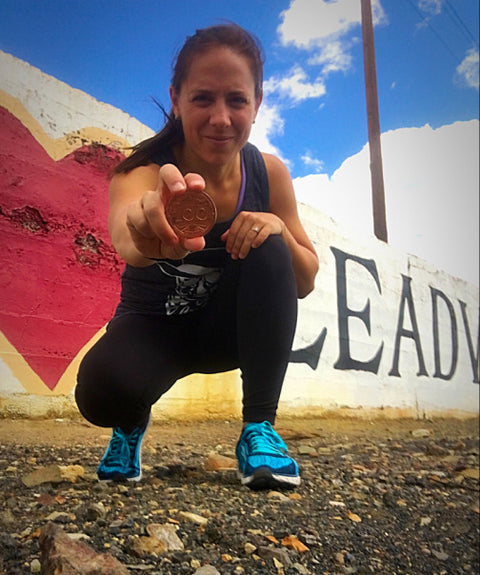This is a guest post from Annie Weiss, MS RD, and Professional Endurance Athlete.
There are so many things to consider when you start running, and even more once you have a few months under your belt. The obvious considerations being distance, season, shoes, terrain, and finally, runners start to think about nutrition. It’s usually once they have mastered the 5k and 10k distance that nutrition starts to play a role in their running endeavors. Whether you are running on the road or rocky trails, nutrition is key. But, there are some nutritional differences between the two sports that runners have to consider before gearing up for their next big race.
Let’s assume you are training for a marathon. You have one race coming up that is a trail marathon at 8000 ft and the following will be a road marathon at sea level. What do you do? What do you eat? How do you hydrate? Does altitude make a difference? Does speed? You see your running buddy eating real food on the trails and gels on the road – what’s the difference?! I venture to guess most people want to know exactly what foods/energy to eat, but don’t forget about the other factors involved…
Here are the major nutritional differences between training for your trail vs road race ….
Location – altitude or sea level racing
You wouldn’t think that elevation would play a role in nutrition, but it’s actually a huge factor when it comes to nutritional needs on the road or trail. Needs can increase by nearly 30% at altitude. So that means that your body needs 30% more nutrition than if you were at sea level – and that can be a TON more additional calories for many runners. When you are running at altitude, it’s really important to eat early and eat often. If you feel great fueling every 60 minutes at home at sea level, consider at altitude fueling now every 20-30 minutes. You can start first with 45 minutes, 35 minutes, and so forth. The more you get in early, the better. Don’t delay nutrition in the first 3-5 miles or you pay for it later around miles 10-15 and beyond. So first things first – if there is elevation, plan to eat more. And, don’t forget that muscle breaks down much faster at altitude, so don’t hesitate to have your recovery shake plus more on top of it!
Speed – Aerobic vs Anaerobic
The next question to ask yourself – will you be comfortably breathing during this race, or will you be working extremely hard leading to mouth breathing? When a person is aerobic, carbohydrate is utilized, but can also be paired with fat to provide energy. This is typically seen in longer trail distances for middle of the pack runners. They may stop at aid stations for longer periods of time and enjoy the run with a friend making nice conversation as they go. Foods I recommend would be peanut butter and jelly sandwiches, cookies, or one of my favs – twinkies. A combo of carbohydrate and fat. Both necessary with this type of running. But what if you decide to go all out and set a course record?! This is when carbohydrate needs to utilized exclusively. With the type of work your body is doing, it’s best to focus on supplemental nutrition and 60-90 grams pf carbohydrate per hour. Gels and liquids are best and for the courageous, blocks and beans (choking hazard!). If the type of carbohydrate used in supplemental fueling doesn’t work for you, I recommend runners make their own…sometimes honey is a great option. Don’t worry about being “natural” or “healthy” in your selections though. The companies that develop gels, etc. are awesome and really created products that are meant to be used in racing. Use them! And certainly, don’t’ go for carbohydrates that are going to be hard for your body to break down. This would be complex carbohydrate. Believe it or not, processed foods are best because, guess what?!…They are already processed for you! Your body doesn’t have to waste energy doing that first step. So – first things first….simple carbohydrate! Then sprinkle in fat during the longer, slower races.
Hydration – is there a difference?
We all know we have to hydrate (with electrolytes!) no matter what the distance or terrain. But does it matter how much? Certainly, like nutrition at altitude, hydration needs are increased – so drink up! But, be careful. During longer events, it’s actually just as easy to become over hydrated as it is to become dehydrated. Watch for signs of edema, or swelling in the hands and ankles, dry month, physical exhaustion/clumsiness, and the key sign – when eating just simply can’t happen anymore…or even the thought of food makes your stomach turn….hydration is off and it’s time to sit down and get your body back on track. Easy ways to stay hydrated…obviously carry a large pack on your back versus using just a single handheld. Typically, runners should be aiming for, at the very least, 24-32oz per hour. But start there and increase hydration as tolerated. Just like nutrition, you have to experiment with fluids especially with longer distances. If you are doing a road race, typically up to a half marathon, you can plan to drink 24oz for the duration of the event if lasting under 90min. When events, race or trail, go longer than that, it’s vital you get in enough water. Hydration needs, as well as sodium and potassium needs, can really only be dictated by a registered dietitian that can compute those individualized numbers. As a general rule of thumb, start with 24-32oz per hour when 2 hours or longer.
Overall, the difference between road and trail running simply comes down to speed and altitude. Simple carbohydrate will always be at the center of your race nutrition plan, and from there, fat may or may not be added in. Certainly, everyone is different with different needs, but if you can start with carbohydrate items first, sprinkle in some fat, and ensure you are drinking each hour…you will be on your way! No race ever goes wrong when you’ve had too much to eat.
Where does Fluid Nutrition PERFORMANCE fit in???
I prefer to use this in my handheld bottles, and sometimes I will add a couple scoops to my pack for consistent intake of carbohydrate. It contains 25g of carbohydrate in 1 scoop (equal to a gel!) as well as sodium, potassium, calcium magnesium, and chloride. All are lost in sweat and must be replaced to keep proper balance within the body. It’s easy on the gut most importantly!



